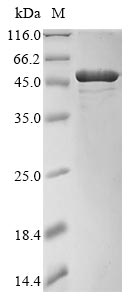Constructing a plasmid encoding the Clostridium perfringens perfringens Phospholipase C (PLC) protein (29-398aa) and the N-terminal 6xHis-tag is the initial step in the general approach to express the recombinant Clostridium perfringens PLC protein. The plasmid is then transformed into E.coli cells. Positive E.coli cells are selected and cultured, protein expression is induced, and cells are lysed. The resulting recombinant Clostridium perfringens PLC protein is then purified through affinity purification, and SDS-PAGE analysis is carried out to verify the presence and assess the purity of the protein. Its purity exceeds 85%.
PLC is a crucial enzyme that helps cells communicate, especially when they're responding to hormones, neurotransmitters, or chemical signals. When activated by these signals, PLC breaks down a molecule called phosphatidylinositol 4,5-bisphosphate (PIP2) into two important substances: inositol 1,4,5-trisphosphate (InsP3) and diacylglycerol (DAG) [1]. These substances are like messengers inside cells and help control things like calcium levels, secretion, cell growth, and changes in cell function [1]. PLC gets switched on by special proteins called G protein-coupled receptors (GPCRs), which also control other parts of the cell [2]. Besides its role in cell signaling, PLC is involved in various other cell activities, like turning on enzymes and affecting how certain substances interact with cell membranes [3][4][5].
Scientists have found PLC in different tiny organisms, like certain bacteria and yeast, suggesting it might help these organisms cause diseases [6][7]. The activity of PLC is influenced by other cell components, such as Na+/H+ exchanger regulatory factor 2 and protein kinase C, showing how complex the control of PLC can be [8][5]. Also, researchers have figured out the detailed structure of PLC from a bacteria called Listeria monocytogenes, which gives us more insights into how this enzyme works in disease-causing bacteria [9].
References:
[1] C. Bizzarri, M. Girolamo, M. D’Orazio, & D. Corda, Evidence that a guanine nucleotide-binding protein linked to a muscarinic receptor inhibits directly phospholipase c., Proceedings of the National Academy of Sciences, vol. 87, no. 12, p. 4889-4893, 1990. https://doi.org/10.1073/pnas.87.12.4889
[2] A. Barr, H. Ali, B. Haribabu, R. Snyderman, & A. Smrcka, Identification of a region at the n-terminus of phospholipase c-β3 that interacts with g protein βγ subunits, Biochemistry, vol. 39, no. 7, p. 1800-1806, 2000. https://doi.org/10.1021/bi992021f
[3] J. Parrish and D. Nichols, Serotonin 5‐ht2a receptor activation induces 2‐arachidonoylglycerol release through a phospholipase c‐dependent mechanism, Journal of Neurochemistry, vol. 99, no. 4, p. 1164-1175, 2006. https://doi.org/10.1111/j.1471-4159.2006.04173.x
[4] V. Mellay, B. Grosse, & M. Lieberherr, Phospholipase c β and membrane action of calcitriol and estradiol, Journal of Biological Chemistry, vol. 272, no. 18, p. 11902-11907, 1997. https://doi.org/10.1074/jbc.272.18.11902
[5] S. Chakraborti, J. Michael, & T. Sanyal, Defining the role of protein kinase c in calcium‐ionophore‐(a23187)‐mediated activation of phospholipase a2 in pulmonary endothelium, European Journal of Biochemistry, vol. 206, no. 3, p. 965-972, 1992. https://doi.org/10.1111/j.1432-1033.1992.tb17007.x
[6] A. Gómez, A. Mve-Obiang, B. Vray, W. Rudnicka, I. Shamputa, F. Portaelset al., Detection of phospholipase c in nontuberculous mycobacteria and its possible role in hemolytic activity, Journal of Clinical Microbiology, vol. 39, no. 4, p. 1396-1401, 2001. https://doi.org/10.1128/jcm.39.4.1396-1401.2001
[7] M. Niewerth and H. Korting, Phospholipases of candida albicans, Mycoses, vol. 44, no. 9-10, p. 361-367, 2001. https://doi.org/10.1046/j.1439-0507.2001.00685.x
[8] J. Hwang, K. Heo, K. Shin, E. Kim, C. Yun, S. Ryuet al., Regulation of phospholipase c-β3 activity by na+/h+ exchanger regulatory factor 2, Journal of Biological Chemistry, vol. 275, no. 22, p. 16632-16637, 2000. https://doi.org/10.1074/jbc.m001410200
[9] J. Moser, B. Gerstel, J. Meyer, T. Chakraborty, J. Wehland, & D. Heinz, Crystal structure of the phosphatidylinositol-specific phospholipase c from the human pathogen listeria monocytogenes, Journal of Molecular Biology, vol. 273, no. 1, p. 269-282, 1997. https://doi.org/10.1006/jmbi.1997.1290






